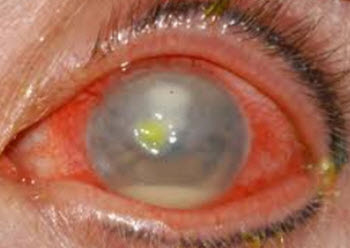What is keratitis?
Keratitis is the Latin word for corneal inflammation. (The cornea is the transparent dome that covers the iris, the pupil and the anterior chamber of the eye.)
 The inflammatory response can be caused by a wide range of factors, including viral infection, bacterial infection, fungal infection, amoeba infection and parasitic worm infection. An infection is not always the reason behind keratitis – snow-blindness and exposure keratitis are two examples of keratitis where the underlying factor isn’t infection.
The inflammatory response can be caused by a wide range of factors, including viral infection, bacterial infection, fungal infection, amoeba infection and parasitic worm infection. An infection is not always the reason behind keratitis – snow-blindness and exposure keratitis are two examples of keratitis where the underlying factor isn’t infection.
Examples of common keratitis symptoms: moderate to intense eye pain, red eye, sensitivity to light, a gritty sensation in the eye, and reduced vision.
It is unusual for keratitis to lead to long-term problems, especially not if the eye receives medical treatment. There however examples of patients where the keratitis caused scarring of the cornea and permanently impacted the eyesight. Keratitis can also spread to other parts of the eye, and a complete loss of the eye is possible under rare circumstances.
How can I prevent keratitis?
That depends on the causative agent. When it comes to keratitis caused by infection, the main prevention is to prevent the introduction of pathogens into the eye.
For CL users, it is important to adhere to a strict hygiene regiment and also stick to the manufacturer’s recommendations when it comes to wear schedule and replacement schedule.
Please note that a CL case can serve as a breeding ground for pathogens.
Ulcerative keratitis
What is ulcerative keratitis?
This is when keratitis causes a disruption of the cornea’s epithelial layer. Since the epithelial layer is protecting the eye’s stroma, a disruption of this layer can cause the keratitis to reach the stroma as well. In serious cases, the inflammation will penetrate not just into the stroma but through the entire stroma – a condition known as descemetoceles. Descemetoceles can rapidly cause corneal perforation.
Once the keratitis is gone, the injury caused by superficial ulcerative keratitis will usually heal on its own within a week or so, because healthy epithelial cells can migrate to the injured area from surrounding tissue. For non-superficial ulcerative keratitis, the healing process will take much longer because cell migration won’t be enough to fix the situation. It is not unusual for such patients to need medical intervention in the form of conjunctival flaps, conjunctival grafts or even corneal transplants.
How can I prevent ulcerative keratitis?
See recommendations for preventing keratitis.
If you have keratitis, immediately stop using CL:s. Seek medical help and follow their advice.
This article was last updated on: April 24, 2016

